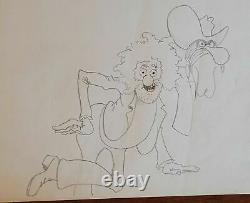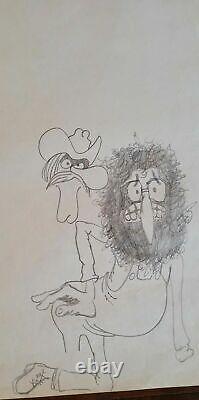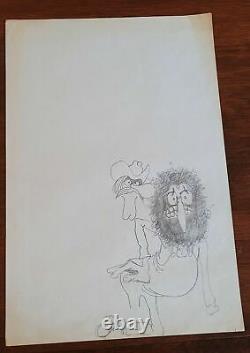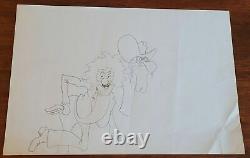Fabulous Furry Freak Brothers Sketch Original Art GILBERT SHELTON 70's







2 original pencil drawings unsigned by Gilbert Shelton of the Faulous Freak Brothers from the 1970's on paper each measuring 12x18 inches. Gilbert Shelton (born May 31, 1940)[2] is an American cartoonist and a key member of the underground comix movement. He is the creator of the iconic underground characters The Fabulous Furry Freak Brothers, Fat Freddy's Cat, and Wonder Wart-Hog. The Fabulous Furry Freak Brothers. Shelton was born in Houston, Texas. He graduated from Lamar High School in Houston. He attended Washington and Lee University, Texas A&M University, and the University of Texas at Austin, where he received his bachelor's degree in the social sciences in 1961.
His early cartoons were published in the University of Texas' humor magazine The Texas Ranger. Directly after graduation, Shelton moved to New York City and got a job editing automotive magazines, where he would sneak his drawings into print. Early work of his was published in Warren Publishing's Help! [1] The idea for the character of Wonder Wart-Hog, a porcine parody of Superman, came to him in 1961. The following year, Shelton moved back to Texas to enroll in graduate school and get a student deferment from the draft.
The first two Wonder Wart-Hog stories appeared in Bacchanal, a short-lived college humor magazine, in the spring of 1962. That same year, he published (in zine form) Frank Stack's The Adventures of Jesus, one of the first underground comix; Stack wrote and drew the comic strip under the name Foolbert Sturgeon. Shelton then became editor of The Texas Ranger[1] and published more Wonder Wart-Hog stories. After switching from graduate school to art school (where he befriended singer Janis Joplin)[4] for two years, he was finally drafted, but Army doctors declared him medically unfit after he admitted to taking psychedelic drugs. [5] After this, in 1964 and 1965, he spent some time in Cleveland, where his girlfriend Pat Brown (another UT alum)[6] was going to the Cleveland Institute of Art. He applied for a job at the Cleveland-based American Greeting Card Company (where a fellow underground comic artist Robert Crumb had worked) but was turned down. [7] Around this time Shelton became art director for the Vulcan Gas Company, a rock music venue in Austin, Texas, where he worked with Jim Franklin. He created a number of posters in the style of contemporary California poster artists such as Victor Moscoso and Rick Griffin. After a year of this, he moved to San Francisco in 1968, hopeful that being closer to the action would enable him to do more poster work; as it turned out, he finally got his break in the world of underground comix. That same year, Millar Publishing Company, who had been publishing regular Wonder Wart-Hog stories since 1966, published two issues of Wonder Wart-Hog.Since moving to France, Shelton has become part of a rhythm and blues group, the Blum Brothers, featuring Shelton on vocals and piano. The band features fellow cartoonist musician Bruno Blum. The Blum Brothers played at the Jockomo, a New Orleans-style bar in the 11th arrondissement of Paris.
Shelton and his wife, literary agent Lora Fountain, left San Francisco in 1979. Gilbert Shelton at the London Film and Comic Con in July 2013. Wonder Wart-Hog (2 issues, Millar Publishing Company, 1967). (Not Only) The Best of Wonder Wart-Hog (3 issues, Rip Off Press and the Print Mint, 1973) - issues #1-2 published by Rip Off Press, #3 by the Print Mint. Wonder Wart-Hog, Hog of Steel (3 issues, Rip Off Press, 1995).Wonder Wart-Hog and The Battle of the Titans (Rip Off Press, 1985). Underground Classics #5 (Rip Off Press, 1987) -titled Wonder Wart-Hog Vol. Wonder Wart-Hog and the Nurds of November (Rip Off Press, 1988). The Best of Wonder Wart-Hog (Knockabout Comix, 2013).
Feds'N' Heads (self-published, 1968) - re-issued in multiple printings by the Print Mint. Give me liberty: A revised history of the American Revolution 1976. Underground Classics #12: "Gilbert Shelton in 3D" (Rip Off Press, 1990).
Die Freak Brothers räumen ab (1982). The Fabulous Furry Freak Brothers (1971). The Fabulous Furry Freak Brothers (1987).
The Fabulous Furry Freak Brothers: Wunderwarzenschwein (1989). The Fat Freddy's Cat Omnibus (2009). The Freak Brothers Omnibus (2008).
Gerhard Seyfried - Die Werke (2008). The New Smithsonian Book of Comic-Book Stories: From Crumb to Clowes (2004).
The Rime of the Ancient Mariner (1989). Rückkehr vom Planet der Schweine (1993).I assume that sometime in your early career you decided to be a cartoonist. But early on, were you thinking that you'd be a cartoonist, or a writer, or an artist, or what? GILBERT SHELTON: I've never really been much of anything other than a cartoonist. I remember that when I was four or five years old I would copy the faces of cartoon characters out of the newspaper comic strips.
I could do Dick Tracy, and Nancy, and Henry. SHELTON: I don't remember Mickey Mouse being in any of our local papers.
STACK: Would you write your own stories? SHELTON: I didn't have enough imagination.I could copy drawings, but I wasn't good at inventing things. I remember being in kindergarten at age five and having the teacher tell us to get out our paper and colors and draw a picture of anything we felt like drawing.
I looked around to see what the other kids were drawing, and they all seemed to be doing a picture of a house with smoke curling up out of the chimney, a lollipop-shaped tree in the yard and the sun in the upper right-hand corner of the sky with lines emanating from it. So I drew the same thing.
I knew that the windows of houses weren't supposed to be right up in the corners, but I drew them that way because the other kids did. The authority of the other kids? SHELTON: Yes, I was the youngest in my class, I think. STACK: Did you read comic books when you were a kid? SHELTON: Yeah, I liked Donald Duck and Little Lulu. You know, Disney never allowed Carl Barks, or anyone else, to sign their names to the stories, but I could tell when a Donald Duck story in any given issue of Walt Disney's Comics and Stories was going to be funny, that is to say written by Barks, by looking at the lettering style. I learned how to read before I was in the first grade, mainly by studying Donald Duck. STACK: Where did you go to school? SHELTON: I went all the way through public school in Houston. I did best in reading and arithmetic at first, but after a couple of years I built up more confidence about drawing. I wasn't usually the best artist in my class but I was usually in the top two or three. STACK: Didn't you tell me once that you didn't take any art classes in high school? SHELTON: I never took art in high school, but I did go to private art classes given by a little old lady when I was 10 or 12 years old. In high school we had a cartoonists' club and I was a member. They gave the club a bulletin board in the front hall and each week we'd have a display of cartoons. STACK: You told me the name of one of your characters.. "Poddy rules the world" was his slogan. Outside of school I would deface local advertising billboards with Poddy graffiti. A sort of early eco-terrorist, you might say. I spray-painted Poddy on the billboards in my neighborhood with such persistence that eventually the billboard companies were unable to sell those spaces to any advertisers, and the billboards fell blank.There were plenty of outstanding athletes. And there were a lot of creative people too. Tommy Sands, for instance, was a student there at the same time I was.
You remember him, the teen-idol singer who married Nancy Sinatra and never did another gig after he divorced her? He was about six years older than me, I think, but I had almost caught up with him in school because he spent a lot of his time doing his daily television show. Also Tommy Tune the dancer was in my class, and Max Neuhaus the sound artist. STACK: What did you do when you finished high school? Did you go straight to college? First I went to Washington and Lee University. That's a small men-only school in Lexington, Virginia. It had about 600 students. STACK: And why did you not continue there? SHELTON: I was bored, and I wasn't doing well in my studies. The only thing to do there was join a fraternity, and I wasn't invited to join. Ninety-five percent of the students at Washington and Lee were in one fraternity or another, so that left me and a dozen or so other weirdos and eccentrics sitting in the local bar, Doc's. That's where I met Stanley Marsh III, later to be a renowned art patron, who commissioned the work of art now known as the Cadillac Ranch -- the row of Cadillacs buried nose-first in concrete with their tailfins sticking up, in Amarillo, Texas. STACK: So did you finish a full year at Washington and Lee? Then I went to the University of Texas for a year, and then Texas A & M for a half year, and then back to the University of Texas where I got my bachelor's degree in the social sciences in 1961.STACK: Why all that moving around? It turned out to be boring there, too. I was driving to Houston or Austin every weekend. And Texas A & M didn't have a student humor magazine.
It was the Texas Ranger that brought me back to the University of Texas. STACK: You had contributed a number of cartoons to the Texas Ranger when I was its editor in the academic year'58-'59... SHELTON: I did some cartoons, but I wasn't part of the social scene. I never went to any of the Ranger parties that year, even though I was invited.
I did sell a few gag cartoons here and there, but I can't recall specifically. STACK: What was the genesis of Wonder Wart-Hog? SHELTON: The idea for this character came to me one day as I was walking down the street in New York in'61.
Maybe they didn't like the fact that I admitted taking drugs like peyote and LSD. STACK: Were you humiliated or delighted? SHELTON: I was glad to get off the hook. Vietnam was really heating up by this time,'64. I thought I was doomed.
STACK: That's one of the first good stories I've heard about the University of Texas art faculty. Well, I thought at the time, and I think lots of other people thought too, that you had an extraordinary feeling for what's funny. You said earlier that you didn't know how to do jokes, but somewhere along you did learn. How did you know if it was funny? Did you just show it to somebody and say, Is this funny?
STACK: Why did you decide to leave Texas, where it seems like there was some kind of scene developing in music and other things, and go to California? In'64 and'65 I spent some time in Cleveland, where my girlfriend Pat Brown was going to the Cleveland Art Institute. STACK: Wasn't Robert Crumb living in Cleveland at this time, too? SHELTON: I think so, but I never actually met Crumb until'68, in New York. In Cleveland I applied for a job at the American Greeting Card Company of Robert Crumb fame, but I was turned down.
I did meet Dave Sheridan in Cleveland then, where he was a student at the Art Institute, and Fred Schrier too. During'64 and'65 I was shuttling around between Austin, Cleveland, and New York. Harvey Kurtzman had started reprinting old Wonder Wart-Hog stories from the Ranger in his "Public Gallery" section of Help! Didn't last long after that. Then I went out to California for the first time in'65, in a truck with a bunch of guys in a motorcycle gang called The Cleveland Gooses. I stayed with friends in Venice and Summerland, California, and lived in Santa Barbara briefly. In March, 1966, Tony Bell and I started doing regular Wonder Wart-Hog stories in an automotive magazine published in Torrance, California, called Peter Millar's DRAG CARTOONS. Then Tony and I moved back to Austin and continued sending in the strips from there until Millar went out of business in'68. One of the reasons that Millar Publishing Company went bust, maybe, was the publication of two issues of Wonder Wart-Hog Quarterly, done by me and Tony Bell and Joe Brown. STACK: Wasn't it the second Wonder Wart-Hog Quarterly that had "The Second Ugliest Thing in the World"? The portrait of Wonder Wart-Hog standing in the same pose as the rejected official portrait of Lyndon Johnson by Peter Hurd? I imagine very few people remember that story now, how Lyndon rejected that portrait, calling it the ugliest thing he had ever seen. Tony Bell did the drawing for Wonder Wart-Hog Quarterly, and there was a big poster done of it too. Probably not many of our readers got the allusion. I wonder whatever happened to that official portrait of L. STACK: I believe somebody bought it and gave it to the National Portrait gallery in Washington, D. SHELTON: Anyway, Wonder Wart-Hog Quarterly failed after two issues.Millar had had 140,000 copies of each printed, and he had to sell half of them to break even. But the thing was too weird for the distributors and most of the copies stayed in the warehouses. I remember looking and looking for a copy on sale at various newsstands around Austin, and I never found one anywhere. STACK: Was there anything being published at this time that anyone would recognize as an underground comic?
SHELTON: The format of Wonder Wart-Hog Quarterly was modeled after Jim Warren's Creepy, with 64 pages in black and white and a cover price of 50 cents. The archetypical underground comic, Zap, didn't appear until a couple of years later. There had been some earlier things that could be called underground comics, like The Adventures of Jesus and Jackson's God Nose, back in'64. STACK: So Wonder Wart-Hog Quarterly sounds like first a career break, then a career setback. What did you do then, in'68?SHELTON: About this time a friend of mine, Houston White, and some other guys opened a rock dance and concert hall on Congress Avenue in Austin -- the Vulcan Gas Company -- and I became art director, in charge of getting the posters done each week. I did a number of posters, in a style influenced by the California poster artists, Victor Moscoso, Rick Griffin, Wes Wilson, Bob Fried, and others. These posters for the Vulcan Gas Company were similar in style to the California ones, but larger, since this was Texas. They were printed by an Austin printer named Johnny Mercer, and some of them were really beautiful, with split-fount inking.
Only about 100 copies of each of these posters were printed, so they're quite rare now. I did this for about a year, until I moved to San Francisco in the summer of'68. Jim Franklin then became art director for the Vulcan Gas Company, and then for Eddie Wilson's Armadillo World Headquarters, which was more successful. A whole art and music scene grew up around the Armadillo World Headquarters, which I missed. STACK: I remember being at a party in Austin and seeing you there with Janis Joplin, if my memory serves me right. SHELTON: Yeah, Janis and I were close friends and it's entirely possible you saw us together. Janis started at the University of Texas in'62. She was studying drama, I think.These were the days of the big folk music revival, and Janis would sing each week at the regular hootenanny in the student union. She was a folk music purist at the time, and when I once suggested to her that she ought to try doing some rock and blues, she rejected the idea. But then she dropped out of school and moved to New York in'64, and then later went out to California with the Texan Chet Helms, and well, the rest is history. STACK: Did the two of you go to California at pretty much the same time? SHELTON: By the time I got to San Francisco, Janis was already a star.
The Freak Brothers, by Gilbert Shelton. Through the years, Shelton created several comic books, filled with riotous slapstick, full-speed action and extremely funny characters, all pleasantly mingled in his extraordinary limber drawing style.
Gilbert Shelton is considered one of the most well-known underground cartoonists. Recently, he has been working in Paris, together with Pic, on the Rock & Roll comic'Not Quite Dead', about the world's most famous band that never made a CD. The Fabulous Furry Freak Brothers, by Gilbert SheltonThe Fabulous Furry Freak Brothers, by Gilbert SheltonThe Fabulous Furry Freak Brothers, by Gilbert Shelton.
He was one of several artists to make a graphic contribution to'Pepperland' (1980), a collective comic book tribute to the store Pepperland, to celebrate its 10th anniversary at the time. Together with 20 other comic artists (Zep, Ptiluc, Frank Margerin, Yslaire, Cosey, Philippe Vuillemin, Milo Manara, Loustal, Max Cabanes, Dupuy & Berberian, François Boucq, Gérald Poussin, Thomas Ott, Frank Pé, Frank Le Gall, Riff Reb's, Eric Buche, Enrico Marini and Valott) he illustrated a record single for the project'20 Vraies Fausses Pochettes De Disque Par 20 Vrais Dessinateurs de BD' (1995). Shelton chose for a song by Clarence "Gatemouth" Brown. This item is in the category "Collectibles\Comic Books & Memorabilia\Original Comic Art". The seller is "memorabilia111" and is located in this country: US. This item can be shipped to United States, Canada, United Kingdom, Denmark, Romania, Slovakia, Bulgaria, Czech Republic, Finland, Hungary, Latvia, Lithuania, Malta, Estonia, Australia, Greece, Portugal, Cyprus, Slovenia, Japan, China, Sweden, South Korea, Indonesia, Taiwan, South Africa, Thailand, Belgium, France, Hong Kong, Ireland, Netherlands, Poland, Spain, Italy, Germany, Austria, Bahamas, Israel, Mexico, New Zealand, Singapore, Switzerland, Norway, Saudi Arabia, United Arab Emirates, Qatar, Kuwait, Bahrain, Republic of Croatia, Malaysia, Brazil, Chile, Colombia, Costa Rica, Panama, Trinidad and Tobago, Guatemala, Honduras, Jamaica, Barbados, Bangladesh, Bermuda, Brunei Darussalam, Bolivia, Ecuador, Egypt, French Guiana, Guernsey, Gibraltar, Guadeloupe, Iceland, Jersey, Jordan, Cambodia, Cayman Islands, Liechtenstein, Sri Lanka, Luxembourg, Monaco, Macau, Martinique, Maldives, Nicaragua, Oman, Peru, Pakistan, Paraguay, Reunion, Vietnam.









